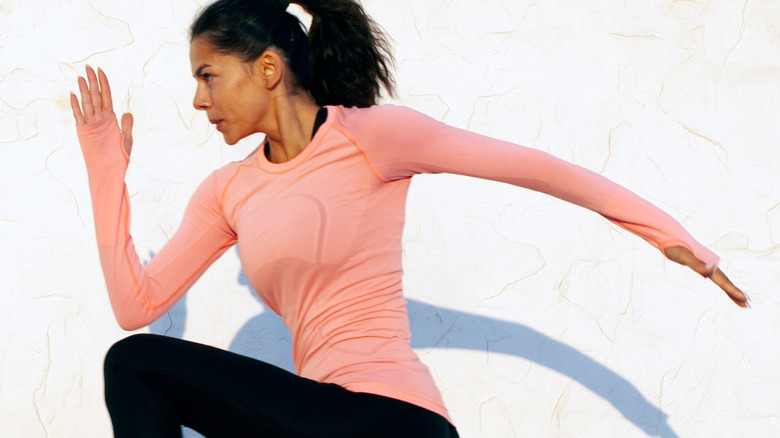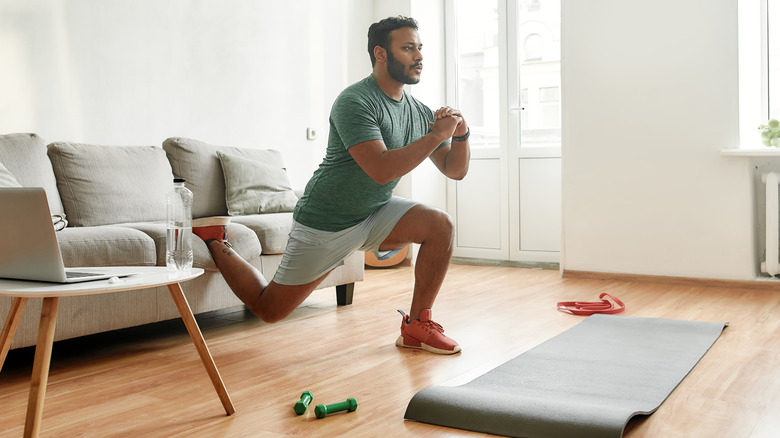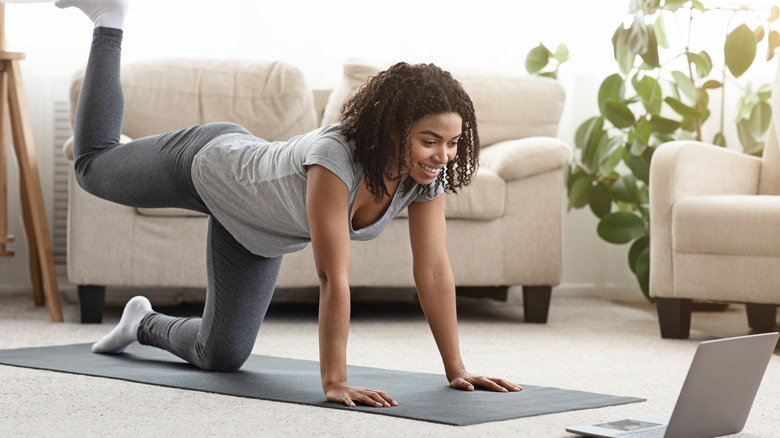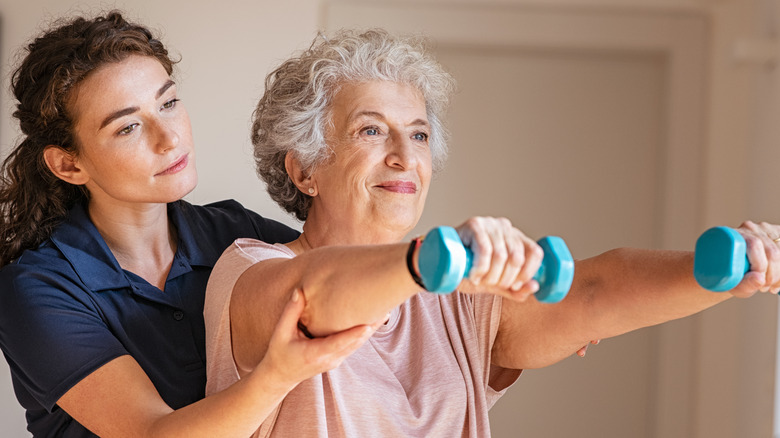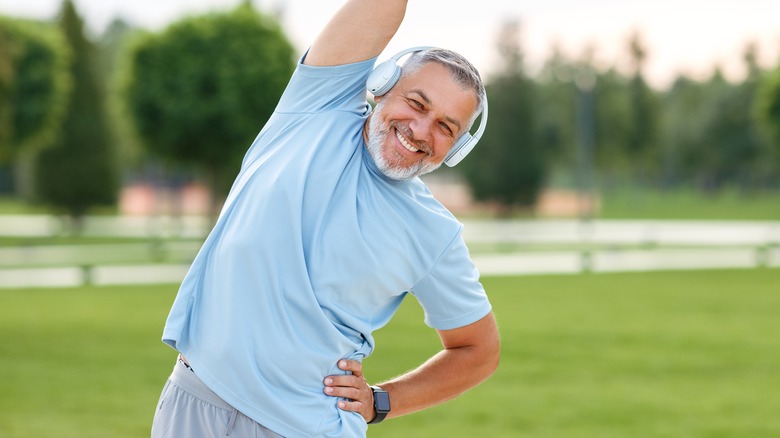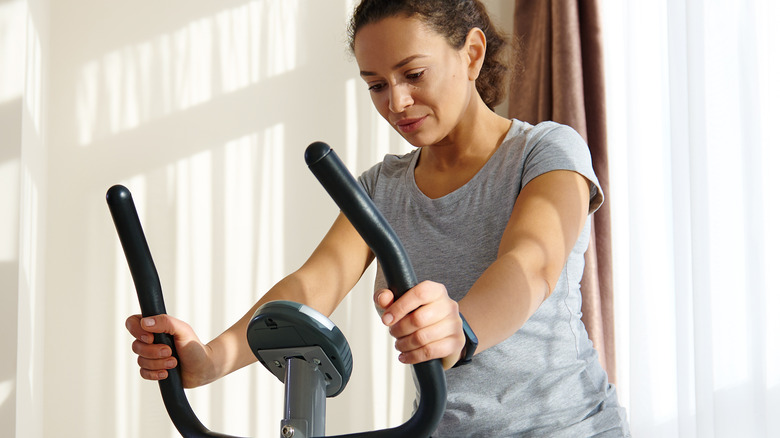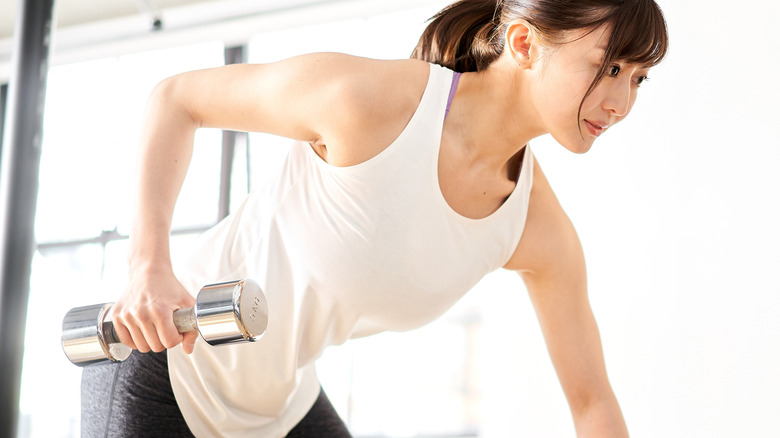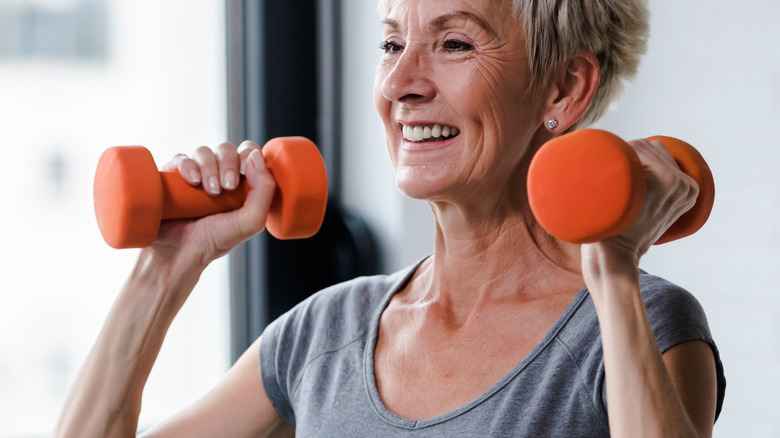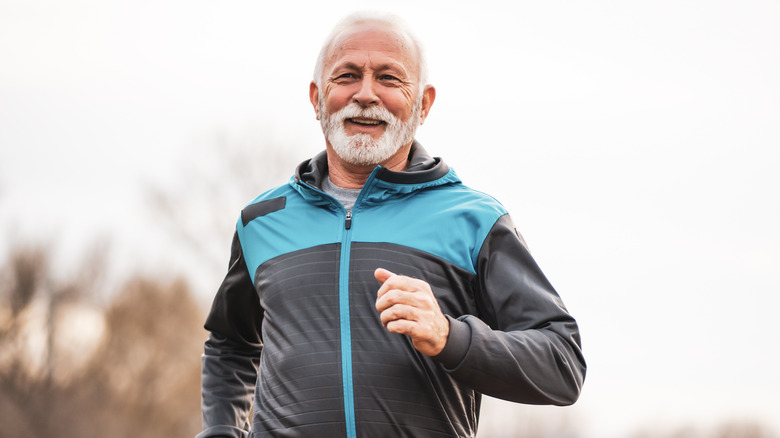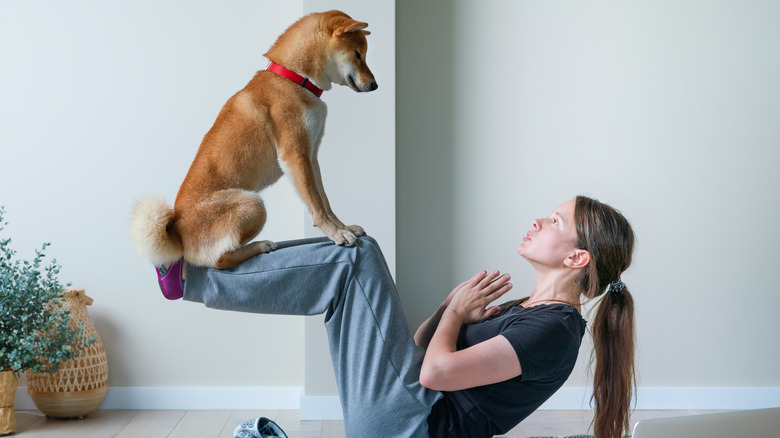Everything You Need To Know About HIIT
For many years, HIIT has been a buzzword in the fitness industry. The acronym stands for high intensity interval training, which is just what it sounds like: short intervals of high intensity exercise. As the American College of Sports Medicine explains, high intensity interval training is so popular in part because HIIT workouts are highly customizable. There's no one-size-fits-all approach to this type of training, but that means you get to design the workouts you actually want and need. This includes choosing the right physical activities for you. Each interval can be a different type of exercise (though you can also repeat exercises if you'd like), and any type of exercise applies.
For instance, if you really hate jumping jacks, or you've never been able to master the burpee, or you don't own a barbell for doing push-ups, the good news is that you never have to include any of these activities. Instead, you can focus on exercises you enjoy and feel comfortable doing. Include a vigorous dance interval for a nice cardio boost if you love to dance, or a jump rope interval if you have a jump rope, or a weight training interval if you want to use your dumbbells, etc. You can also add free weights to exercises like squats or lunges, making them more challenging. The possibilities are endless. Read on to learn more about HIIT workouts and how to design your own.
HIIT workouts alternate periods of work and rest
The American College of Sports Medicine defines high intensity interval training as "repeated bouts of high intensity effort followed by varied recovery times." The recovery times are crucial, because high intensity exercise simply can't be performed for an extended period of time. The high intensity exercise in these workouts should be performed at 80% to 95% of your maximum heart rate, i.e. your best estimate of the fastest heart rate your body can handle without overexerting yourself. In other words, your goal is to exercise about as vigorously as you can. (There are many ways to estimate your maximum heart rate — the CDC has a guide to help you get started.)
These short bursts of activity are known as anaerobic exercise (via Healthline). Anaerobic exercise requires more energy than aerobic exercise and quickly burns through your body's oxygen, at which point your muscles begin to release stored glucose. This process produces lactic acid and can't be sustained for more than a few seconds, or a few minutes at maximum. That said, this exercise is extremely beneficial. It just needs to be done carefully. The ACSM recommends rest intervals that last as long as the work intervals, but you can experiment to find the right ratio of work to rest for your workouts. The recovery periods can also be active, including low intensity exercises like walking or stretching.
HIIT workouts can be as short as 20 minutes – or even 5 minutes
A major benefit of including HIIT workouts in your exercise routine is that these workouts can be done very quickly. This is in contrast to light or moderate cardio exercise (which typically needs to be done for at least 30 minutes to experience benefits). On a busy day, you only need a few minutes to spare for HIIT. The American College of Sports Medicine says these workouts can be anywhere from 20 minutes to 60 minutes, but some other sources suggest even shorter workouts can still be beneficial. A review from the Journal of Physiology found HIIT workouts that were less than 15 minutes could still provide health benefits.
In fact, Everyday Health suggests that even a 5-minute HIIT workout can be beneficial, in part because it can help build your stamina for longer HIIT workouts. Keep in mind you'll want to include a brief warm-up and cool-down before and after the workout, which will add time to the workout, but you can make your workout even shorter if you need to. A study from the American Journal of Physiology found that just two minutes of extremely vigorous exercise –- performed as four 30-second intervals — could be as beneficial as 30 minutes of continuous cardiovascular exercise.
HIIT workouts can be done at home with no equipment
Many strength training routines require the use of expensive gym equipment, but HIIT workouts can be done with no equipment, from the comfort of your home (via NBC News). You won't even need that much space. These home workouts make use of bodyweight exercises, or strength training exercises that use just your body weight for resistance. For instance, HIIT workouts may include push-ups, sit-ups, squats, or holding a plank position. Each of these bodyweight exercises has endless variations, and each provides significant health benefits.
As an example, orthopedic surgeon and sports medicine specialist Dr. Matthew Boes claims that practicing squats as part of a fitness routine can help to prevent injury, not just in sports, but in everyday activities. This is because the squat uses a basic movement we all have to perform every time we sit down, and doing this movement without good form over time can lead to chronic injuries, such as lower back problems. For this reason, including squats in your HIIT workout will train your muscles to squat correctly and reduce your risk of lower back injuries, as long as you learn how to squat with correct form.
Anyone can do HIIT workouts
HIIT workouts may seem intimidating at first, but in reality, anyone can do them (via the Cleveland Clinic). For example, a study from the Journal of Life and Environmental Sciences found that HIIT workouts were not only safe and beneficial for middle-aged and older adults with knee osteoarthritis, but these workouts also led to bigger improvements in physical function than continuous cardiovascular exercise. Similarly, another study from the Journal of the American Heart Association found HIIT exercise to be safe and effective for patients dealing with coronary artery disease (heart disease).
The idea that older adults should avoid vigorous exercise is a myth. In fact, just the opposite is true: It's important to work on building strength as you age, in part to help diminish the effects of age-related muscle atrophy (via the CDC). A systematic review from the Journal of Aging and Physical Activity found that HIIT workouts could help older adults increase their cardiovascular fitness. Additionally, a study from the International Journal of Sports Medicine found that HIIT exercise could improve grip strength, physical functioning, and quality of life (among other things). As with many other studies on this subject, the study from the International Journal of Sports Medicine found HIIT to be more effective than pure cardio in improving these health metrics in older adults.
Talk to your healthcare provider if you are considering trying HIIT exercise but concerned about a particular health condition.
You can design your own HIIT workout to fit your needs
HIIT workouts can be tailored to any fitness level or lifestyle. If you have specific goals, you can focus on including exercises that will help you meet those goals, whereas if you're recovering from an injury, you can make sure not to include any exercises that might exacerbate the injury.
For instance, low impact exercises put less stress on your joints than high impact exercises (via Healthline), making them safe for those recovering from injury or illness. Of course, low impact doesn't mean low intensity, meaning you can get the same benefits from low impact exercise that you get from high impact exercise (via a study from Medicine and Science in Sports and Exercise). And you have no shortage of low impact exercise options to choose from. Many bodyweight exercises are also low impact, making them a great option for those who don't have equipment or who need to go easy on their joints. These include exercises like squats, crunches, push-ups, planks, mountain climbers, and glute bridges.
Exercises that include a jump, such as jumping jacks and burpees, are high impact, but they can also be modified to be low impact when necessary. For jumping jacks, instead of jumping, you can step from side to side while bringing your arms overhead (via Verywell Fit). For burpees, you can simply remove the jump.
HIIT exercise improves cardiorespiratory health more than cardio alone
According to the American College of Sports Medicine, HIIT workouts can include both strength training and cardiovascular exercise. But regardless of the type of exercise you do, you'll get cardiovascular benefits from performing it at a vigorous intensity. The ACSM explains that HIIT exercise should be performed at 80% to 95% of a person's maximum heart rate, meaning you're getting your heart rate up almost as high as it can go. This is much higher than the highest your heart rate will get from walking or other low intensity cardio.
In fact, a study from the British Medical Journal – Open Sport Exercise Medicine suggests that HIIT workouts can lead to even greater improvements in cardiovascular health than cardiovascular exercise alone. A growing body of research supports this claim: A systematic review and meta analysis from Sports Medicine analyzed 28 controlled trials, and found that HIIT caused greater gains in VO2 max as compared with traditional endurance training. VO2 max refers to the maximum amount of oxygen available to your body during exercise (via Healthline) and is a standard measure of cardiovascular health. It makes sense that HIIT exercise can have such a substantial effect on VO2 max: Consistently pushing yourself to work at the highest intensity possible for you will increase your capacity for high intensity exercise over time.
HIIT exercise increases levels of irisin, a calorie-burning hormone, more than cardio alone
When we think of exercises that will help us burn fat and lose weight, we tend to think of cardiovascular exercise. This is in part because lower to moderate intensity cardiovascular exercise, or exercise performed at around 70% of your maximum heart rate, is defined as the fat-burning zone (via Healthline). This name comes from the fact that your body fuels this type of exercise by burning fat, whereas higher intensity exercise triggers a switch from fat to carbohydrates as the main source of fuel.
Unfortunately, the name "fat-burning zone" may make it sound as though this is the most effective exercise for burning fat. In reality, however, higher intensity exercise can lead to more fat loss than pure cardiovascular exercise, as demonstrated by a study from Diabetology and Metabolic Syndrome. This study measured muscle and blood levels of irisin, a fat-burning hormone, after a single session of exercise: either aerobic (cardiovascular) exercise or HIIT exercise. The study found an increase in irisin levels following the HIIT workout, but not following the aerobic workout. Raised irisin levels after HIIT exercise suggest the body continues burning fat long after the exercise is over, as the American College of Sports Medicine confirms: "HIIT workouts tend to burn more calories than traditional workouts, especially after the workout."
HIIT exercise can improve bone mineral density
A study from the Journal of Bone and Mineral Research suggests a high intensity resistance training exercise program can improve bone mineral density in postmenopausal women with osteoporosis. This has been a groundbreaking finding, as high intensity resistance training traditionally hasn't been recommended for those with osteoporosis due to concerns about an increased risk of fractures. Despite these concerns, no adverse effects were observed among the osteoporosis patients who practiced this exercise. High intensity resistance training appears to be both safe and effective as part of a treatment plan for postmenopausal women with osteoporosis.
But how does high intensity resistance training compare to high intensity interval training? The two are actually very similar, but the main difference is that high intensity resistance training focuses solely on weight training and building strength, and is typically a little less vigorous and cardio-focused than HIIT (via CNET). In general, though, there's a lot of overlap: Both types of workouts alternate periods of intense activity with periods of rest, and both can include some of the same types of exercises. In this sense, both categories could apply to the same workout. That said, the results of the study from the Journal of Bone and Mineral Research seem to suggest that resistance training should be the focus of HIIT workouts for those looking to improve bone mineral density.
HIIT exercise may increase muscle mass
HIIT exercise has numerous benefits for cardiovascular health (via a study from the British Medical Journal – Open Sport Exercise Medicine), but it can also help you build strength. A randomized controlled trial from the Journal of Science and Medicine in Sport found that HIIT exercise could increase muscle size in overweight and obese adults. HIIT exercise is also known to burn fat (via a study from Diabetology and Metabolic Syndrome), suggesting it can simultaneously burn fat and build muscle.
However, you'll need to be careful not to overdo it. The American College of Sports Medicine suggests doing HIIT workouts just two or three times per week, or even just once a week if you're new to it. This is because HIIT uses more energy than steady state cardio, so you'll need more time to recover in between sessions. If you cheat yourself out of sufficient recovery time, you may also be cheating yourself out of muscle growth: Without sufficient rest after a strength training workout, your muscles aren't able to rebuild and grow, plus your risk of injury skyrockets. So, don't make the mistake of planning HIIT workouts focused on strength training every day of the week. As a general rule, the more intense an exercise, the less frequently it should be done.
HIIT exercise can reduce blood sugar
A systematic review and meta analysis from the British Journal of Sports Medicine analyzed 65 studies that focused on the effects of HIIT exercise. This study found numerous health benefits to be associated with a short-term HIIT exercise routine (less than 12 weeks), including improved VO2 max (maximum oxygen available during exercise), blood pressure, and fasting glucose. Additionally, a study from Experimental Gerontology found that HIIT exercise could decrease insulin resistance in older adults more so than moderate intensity continuous training (i.e., steady state cardio).
The fact that HIIT exercise has been found to improve blood glucose control suggests that HIIT exercise could be of particular benefit to those with diabetes. In fact, a review from the American Diabetes Association points to HIIT exercise possibly providing greater improvements to blood glucose control than steady state cardio in those with diabetes. This is partly due to the fact that a single bout of intense exercise can increase insulin sensitivity for up to two days afterwards. Thus, as the authors point out, some of the benefits to insulin and blood sugar control that are associated with HIIT exercise can be attributed to the effects of the most recent HIIT workout. With this in mind, it's clear that some of the benefits of HIIT exercise will be experienced after just one workout.
HIIT exercise can increase your resting metabolic rate even after your workout
As explained by the American College of Sports Medicine, your body will continue burning calories for long after your HIIT workout is over. This is part of what makes HIIT exercise so beneficial: Even though you only need 10 or 20 minutes to do it, your metabolism will remain revved up after you stop.
In fact, HIIT exercise can increase your resting metabolic rate after it's over more so than steady state cardio or resistance training, according to a study from Sports Medicine. Having an increased resting metabolic rate means your body is burning more calories while you're at rest, so this explains how HIIT exercise keeps your body burning calories after it's over. The study from Sports Medicine also found that HIIT exercise increased the respiratory exchange ratio after the exercise was over more so than the other two types of exercise. The respiratory exchange ratio is the ratio of the amount of carbon dioxide produced by the body to the amount of oxygen consumed. It's an indirect measure of your muscular capacity for energy as well as your cardiovascular health (via a study from Clinical Medicine).
HIIT workouts shouldn't be done more than twice or thrice a week
If you are new to HIIT exercise, the American College of Sports Medicine suggests doing these workouts just once a week. After a few weeks of doing so, you may be able to increase the frequency to two or three times per week, but it's not recommended to do these workouts more often than that. As Urology of Virginia explains, if you're able to do these workouts upwards of five days per week, you're most likely not pushing yourself to your limit. And if you're actually pushing yourself to your limit more than five days a week, you're not letting your muscles rebuild and putting yourself at serious risk of injury. Your body needs time to recover after anaerobic exercise in order to reap the benefits.
Mary Morrison, DScPT of the Cleveland Clinic, suggests that those who are new to HIIT should take it slow at first. For instance, intervals with longer rest periods are a good idea for beginners, such as 30 seconds of high intensity exercise followed by two to three minutes of rest or light activity. That may not sound like much, but 30 seconds will feel like an eternity if you've never tried doing jumping jacks as quickly as you can for that amount of time. You may want to experiment with different interval lengths to get a sense of how long your body can currently sustain intense anaerobic exercise.
Alternate HIIT workouts and pure cardio workouts to maximize their benefits
Since HIIT exercise has been shown to improve cardiovascular health more than cardio alone (via a systematic review and meta analysis from Sports Medicine), you may be wondering if you should just replace all the cardio you currently do with HIIT workouts. But there are a few reasons why this is neither recommended nor feasible. For one thing, habit change doesn't happen overnight. Gradually easing yourself into a new routine is more likely to help it stick than jumping into it all at once. More importantly, though, HIIT shouldn't replace cardio so much as complement it.
After all, aerobic exercise is better than no exercise. For instance, a systematic review from the Cochrane Database of Systematic Reviews found aerobic exercise to reduce mortality from cardiac events among those with heart disease. Keep in mind that moderate intensity cardio workouts can be done up to five days per week (via Healthline), whereas HIIT workouts can only be done around three days per week. Doing cardio on your days off from HIIT is a good way to stay active.
In fact, light intensity cardio can actually help with muscle soreness from more vigorous workouts. When you experience delayed onset muscle soreness (DOMS), you might think you should avoid working out, but a light activity like walking or stretching can help increase blood flow to your muscles and provide some relief (via Healthline).
HIIT exercises can be incorporated into your daily life
Even if you're new to HIIT exercise, you most likely aren't new to short bursts of anaerobic exercise. If you've ever had to carry luggage heavy enough that you needed to take breaks, or if you've ever had to sprint to catch a bus, then you've experienced anaerobic exercise.
HIIT workouts can be done with no equipment (via NBC News), but you can also use any sufficiently heavy object as a free weight. Consider the things you regularly need to lift in your everyday life: briefcases, backpacks, grocery bags, packages, watercooler jugs, small children, etc. According to Healthline, the "suitcase carry" is a type of exercise you can intentionally practice in which you're carrying something heavy like a suitcase in your hand as you walk around. With this in mind, it's worth considering what sort of heavy lifting you need to do in your daily life, and how to practice it intentionally in order to improve your form.
It's also worth considering how much time you spend sitting each day, and how to break up long periods of sitting with brief exercise. For instance, standing up to do vigorous jumping jacks every few hours can be an effective way to get small amounts of HIIT exercise throughout the day. No matter how busy you are or what sort of lifestyle you have, the possibilities for incorporating HIIT exercise into your lifestyle are endless.

